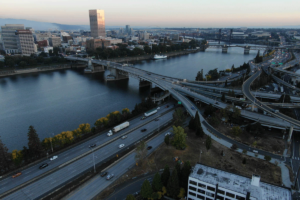Most people not heavily involved in the drone industry are unaware of the growing swell of arguments around who regulates where drones are allowed to operate. Some advocate for handing over a slice of the lowest levels of the airspace to the states. We at DSPA do not agree with this line of thought. That being said, we do not discount state and local police powers.
The bulk of these discussions center around the interpretation of a Supreme Court case from 1946, United States v. Causby. This case dealt with military aircraft, regularly operating at low altitude, over Causby’s farm, and those operations scared his chickens enough that they died. The outcome and interpretation are disputed by many, so I am not going to get into that in this article, rather, I am going to propose some novel yet simple arguments about the regulation of the National Airspace System (NAS).
Establishing the FAA
First, let’s consider the establishment of the Federal Aviation Administration (FAA), or the Federal Aviation Agency as it was named in 1958, under the Federal Aviation Act from Public Law 85-726. The FAA was formed as the unified body for keeping our NAS safe. One of their mandates was to establish, “rules as to safe altitudes of flight and rules for the prevention of collision between aircraft, between aircraft and land or water vehicles, and between aircraft and airborne objects.” (PL 85-726 at 750). One of the easiest ways we started with preventing collisions was through segregation or aircraft, which means that drones are not often operating near traditional aircraft. As we integrate drones into the NAS, that strict segregation will likely change. The mandate was forward looking about what would fall under FAA jurisdiction. “‘Aircraft’ means any contrivance now known or hereafter invented, used, or designed for navigation of or flight in the air.” (id, at 737). With this future focused definition, aircraft like drones, are made subject to FAA regulation. Different aircraft have different flight envelopes and safe minimum operating altitudes, so, a plane, that operates above 500 feet does not present the same safety case as a drone flying at 30 feet.
Sectional Charts
Second, our NAS is broken down into different classes of airspace. Some of that airspace is controlled, while a large amount of it is uncontrolled. Pilots use Sectional Charts for navigation planning as well as situational awareness of obstacles, locations of runways, general population density, and a whole host of other things. On the face of these charts, it is easy to see “SFC” in many places, which designates that the airspace reaches to the surface, or all the way to ground level. These charts cover the whole of the airspace in the United States.
LAANC
Third, the Low Altitude Authorization and Notification Capability (LAANC), is the way in which remote pilots can gain clearance to fly drones in controlled airspace. LAANC has associated grid maps, which use a circle extending around airports and divided into boxes. Each of those boxes, or grids, list a number representing the maximum safe altitude of operation that you can fly a drone with authorization and not need to further coordinate with air traffic control (ATC). Some of these grids are down to zero, because it would not be safe to fly a drone at the end of a runway without coordination. Other grids go all the way up to 400 feet. LAANC enabled airports exist all over the country, and drones have been filing through this system for years.
Pilot Ground Actions
Fourth, pilot actions when they are on the ground are also subject to regulation by the FAA. Whether you are flying the right stick in a traditional aircraft, or using a joystick to fly your drone from the ground, you must check the aircraft for airworthiness prior to takeoff. This could mean physically assessing the condition of the propellers and body of the aircraft. Also, pilots must consider whether they are in a safe operating environment, meaning, they look at the weather, nearby obstacles, and any other safety considerations in the vicinity. Finally, a pilot must do a mental assessment of themselves and their crew. Are all members fit to operate, or should something be changed. The upshot here is that pilots are taking actions on the ground that are dictated by federal law.
Crashes
In the event of an accident in the air, the aftermath usually ends up on the ground. Safety in operations is meant to minimize risk to both people and property on the ground. When the National Transportation Safety Board (NTSB) undertakes an investigation, they do it on the ground, along with assessing what may have gone wrong while in flight.
Temporary Flight Restrictions (TFRs)
The final area we see federal jurisdiction over operations is with TFRs. Consider the recent tragic building collapse in Miami. The FAA issued a TFR that extends, “From the surface up to and including 3000 feet MSL.” The authority for this specific restriction comes from 14 CFR §91.137. This specific TFR covers a disaster situation, but it is not the only situation where aircraft operations are prohibited by the FAA.
There are also TFRs in place around sensitive areas on the ground, like the Washington D.C. area. To operate in the DC exclusion zone, companies must get approval directly from the Transportation Safety Administration (TSA), which is part of the federal Department of Homeland Security. Standing TFRs exist in the vicinity of the homes of former US Presidents. There are TFRs in place around Walt Disney properties. Generally speaking, these TFRs are used to protect specific people and property located on the ground.
Other TFRs are in place around large sporting events and air shows. The authority for these restrictions is found in 14 CFR §91.145. These TFRs focus around gatherings with lots of people on the ground or airspace that will be congested at low levels from air shows.
These TFRs are administered with local coordination, to provide insight and access to those in the physical vicinity. Authority comes from federal rules though.
Summary
Let’s summarize. Taking a simple approach to some arguments that we have not heard in the industry, we came up with the following:.
- The FAA was established to ensure the safety of aircraft in the NAS and minimum safe operating altitudes. Drones are aircraft and they have different flight characteristics than traditional airplanes meaning they usually operate near the ground.
- The Class airspace system noted on Sectionals clearly designates airspace to the surface.
- LAANC also clearly designates airspace and operations to the ground.
- Pilot actions on the ground, in relation to flights, are governed by Federal Law.
- Accidents end up on the ground and are investigated by the NTSB.
- TFRs are in place or can be used in sensitive locations across the US and are administered by the FAA
What do you think?
We want to see state and local interests considered in the future of drone operations, but we do not want to see a patchwork of laws that would hurt small businesses, potentially endanger the safety of aircraft operations, and prevent the expansion of this exciting industry to some of the locations that wish to regulate it.


